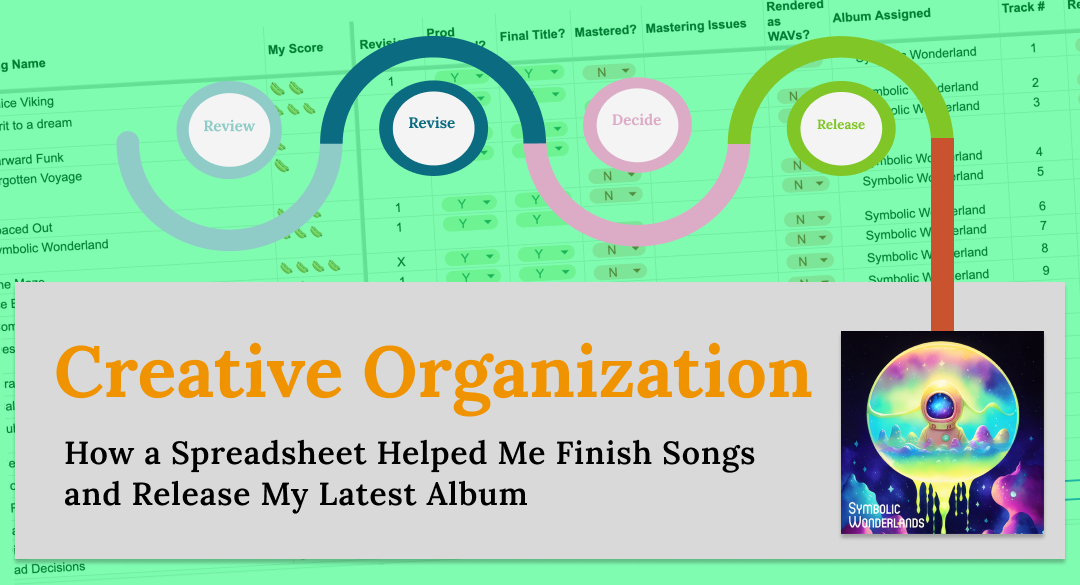Have you ever struggled to finish a creative project? Felt disorganized, uncertain, or unmotivated when it comes to making progress on a single song or even finishing an entire multiple song album release?
As a musician and songwriter, I know how challenging it can be to manage a creative process that involves multiple stages and tasks. As creatives, we often think organization, productivity and project management goes against what it means to be creative. We’ve been told and tend to believe that disorder fuels creativity and that structure and “productivity” might even stifle our muse and genius.
As an independent artist, I am responsible for every aspect of my music production, from songwriting to mixing and mastering. As much as I enjoy the creative aspect of music-making especially the state of flow I can get into starting a new song, I struggle a lot staying productive and making progress too. Even though I recognize the importance of tangible artistic creations, it’s challenging to finish and release a song.
That’s where creative organization comes in. For me, creative organization describes the tools and practices we can use to manage the multi-step process of reviewing, revising and finishing any creative project. There are a lot of different productivity approaches and tools you can leverage to manage your creative process. A dive into productivity goes beyond this post. Quite simply, creative organization should be thought of as a way for you to stay organized in order to take meaningful next steps on the stage of your project and track your process and progress towards finishing.
Recently, as a music producer, I was struggling to finish my album and make tangible progress on the individual tracks I had started. Happily, I had nearly 20 or 25 initial tracks to work on following a productive and flow-filled period that I describe in my post on my 30-Day Songwriting Challenge. Unfortunately they were all unfinished in some way. They needed work. Some needed basic music production work to complete the sound, while others likely required additional songwriting, melodies and instrumentation. Unfortunately, after picking my initial selection, things weren’t moving forward. I had vague intentions to finish the album, but I wasn’t putting in the work. I was at a creative and organizational impasse.
In that moment of uncertainty and disorganization, I took the simple step to create a spreadsheet, a tool normally used for accounting, to help me manage and organize my creative process. In this spreadsheet I initially dumped in the titles and duration of my selected songs. I then added a column for feedback and notes and a checklist column to track if I had reviewed the song. From there I started reviewing songs and adding notes. I added more columns of steps I needed to complete (like review, revise, remix, master, finalize title, etc) and started completing them one by one. Slowly by surely and as I’ll describe in this post, my album management spreadsheet enabled me to confidently and quickly move forward with a host of tasks. I started revising. Songs got better. I was able to make decisions about the overall project and individual tracks. Certain songs got dropped, based on lack of progress. The steps and ratings in the spreadsheet helped ease those decisions. All of this was tracked and visually transparent by using this spreadsheet for project management. And in much less time than I had imagine, my songs were ready, my album was ready, and I was ready to release it.
Whether or not use a spreadsheet or even the spreadsheet tool I used, namely Google Sheets, I believe creative organization is an underappreciated aspect of being a creative. For me, a spreadsheet was a powerful tool for managing my creative process. This simple spreadsheet was a flexible way to keep track of all the moving parts. It allowed me to see everything at a glance, from the basic information about each song to the progress of each individual track to finally checking off a song’s readiness to release. In short, this simple spreadsheet was a flexible way to keep track of all the moving parts.
📁 Download/copy/edit your music producer creative spreadsheet now
In this blog post, I want to share my personal experience with using a spreadsheet to streamline my music production process and how it helped me stay organized and focused towards finishing songs and completing my latest album project. I’ll go over why productivity and creative organization are important for all creatives. I’ll delve into the specifics on how I setup and structured my spreadsheet to track my progress on individual tracks as well as additional checklist items I used.
Ultimately, the goal of this blog post is to enable other musicians and music producers who may be struggling with staying organized and uncertain with how to manage a multiple step release like an album. As independent artists, the music production can be extra challenging since we don’t have a team around us to support us and the relay race we are running is entirely on our own. Hopefully it can help anyone in a similar struggle consider alternative mental models, productivity processes and tools to move forward and finish whatever they are working on.
Productivity and Why Creative Organization Matters
Creativity can be unpredictable and chaotic, but productivity is still essential to success. There are a lot of examples of artists whose creative process seems to flourish on chaos. It’s okay to think of much of what happens in a creative pursuit as mysterious and nonlinear. That said, I’m here to tell you that at the end of the day even the most chaotic and disorganized of artists do one simple thing: they ship creative work.
Actually, shipping creative work should be part of what you group under the rubic of being creative. And, in fact, there is evidence to indicate that the quantity of creative output is correlated with creative success too.
In his book, Originals: How Non-Conformists Move the World, Adam Grant notes that while we are most familar with his classics, Shakespeare was incredibly productive artist. Specifically, “in the span of two decades…he produced 37 plays and 154 sonnet.” Similarly, “To generate a handful of masterworks, Mozart composed more than 600 pieces before his death at thirty-five, Beethoven produced 650 in his lifetime, and Bach wrote over a thousand…Picasso’s oeuvre includes more than 1,800 paintings, 1,200 sculptures, 2,800 ceramics, and 12,000 drawings…In science, Einstein [had] 248 publications.” Though there are many “one-hit” wonders and one-off success, as Grant argues, the evidence shows that the greatest artists and scientists (think Nobel Prize winner) were also the most quantitatively productive too. In short, greatness comes in large part from shipping a large volume of work.
There is a whole range of factors that drive these creatives to productivity and subsequently the chance of success and greatness too. To simplify this down, I believe there are two critical components to being a productive creative.
First, creating a wealth of first drafts and initial versions. If you want to have creative work to finish and ship, you have to get started and put something down. In the case of music it means writing, riffing and jamming on new songs and song demos. There are various strategies a creative can deploy to generate new ideas. As I documented in my post on dedicating a month to new song creation, I assembled an environment and tooling that made it easy to get started (Template!) and then made it a habit to show up daily and try to create something fresh. Personally I used various starting points but through that month, I discovered that the combination of intention, routine, and flow-centered music writing resulted in 31 new songs in just 31 days. There are a lot of strategies and approach to consider with getting started, and I highly encourage a divergent thinking approach.
Second, along with generating first drafts (often crappy, let’s be honest), the other critical component to productive creativity is selecting from these early drafts, improving them, and ultimately finishing them. Releasing your creative work is what it means to be a creative. Until a creative project gets shipped it’s still in-utero, a baby in the womb. In order to play out a full creative idea or project it is essential that you ship it.
Finishing and shipping creative work can be really hard. Emotionally it’s hard to let go of a piece of creative work you’ve been developing. It’s hard not to see flaws in the things we make, judge our creations as not quite good enough or claim endless that our song, piece of writing or other artistic creation can and should be even better. Releasing it comes with external judgement and possibly rejection. Our peers and fans might not like what we create. You don’t really “fail” if it’s never really released and you can avoid the pain of rejection or worse yet simply not being ignored or unheard.
Beyond just letting go of your work, there are a myrid of steps between the first version or draft and the final version you release. It can be challenging to know what is the next step and keep track of what’s done and what’s left to do. Whether it’s a song, a piece of writing, visual art or even code, shipping creative work demands a certain amount of organization and productivity. In order for art to find a place in the world, you need to finish it so it can be shared. As such, creative organization is key part of being a productive artist.
There is a lot to consider about our brains too to consider when it comes to productivity and creativity too. Productivity is a topic I’ve written and throught heavily on. At the core of my personal and professional productivity process is David Allen’s Getting Things Done (GTD) methodology and a task management tool called Todoist. If you are interested in that topic, I recommend reading my two-part blog series: Getting Things Done with Todoist and Tracking Your Tasks with Todoist. Beyond just task management, I found weekly reviews to be immensely powerful best practice for setting intentions and reflection on past week and week ahead.
In spite having pretty good productivity tools and practices, it might seem surprising that I ended up using a spreadsheet to organize and streamline my creative process and finish my album, especially since generally speaking a spreadsheet is for accounting and managing numbers rather than a creative endeavour.
How I Created My Creative Organization Spreadsheet
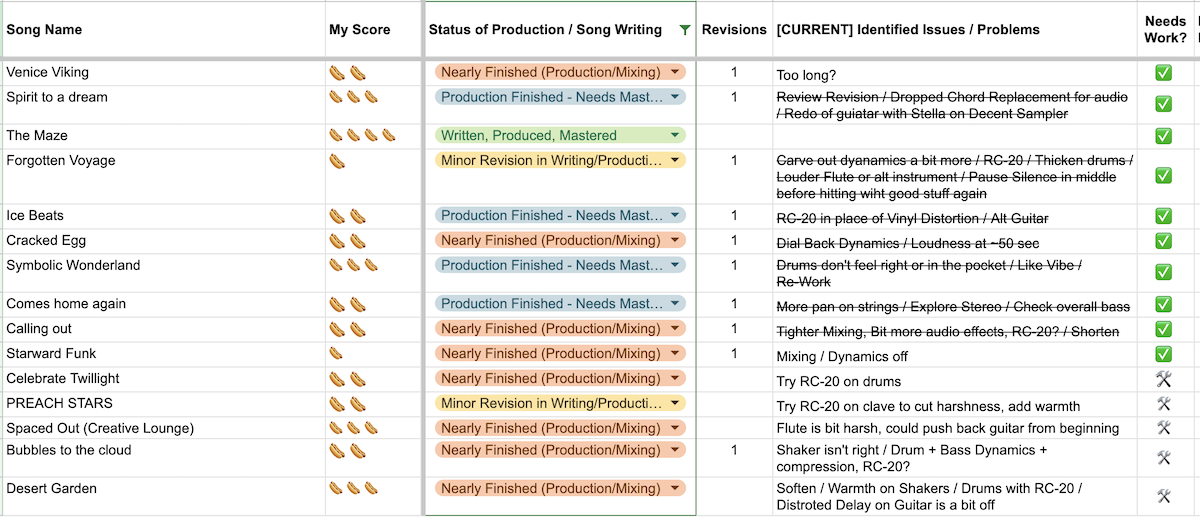
The day I ended up creating this spreadsheet I was again peering down my list of Todo’s and weekly goals seeing that single line: “Finish Album.” I was blocked.
As productivity “guru” David Allen writes in Getting Things Done and neuroscientist Daniel Levitin in The Organized Mind, two writers and books I highly recommend, the mistake I was making in thinking about a task like “finish album” was that it was a project, not a task. One of the best mental hacks we can do when struggling to make progress on a project is simply ask ourselves, “What is the next step I should take here?” Ironically I had failed to break down my goal or project of finishing the album into steps. I had a vague intention but didn’t know the next best step to act on.
By adding all of my initial songs into a spreadsheet, I had taken a step of creating a list. By adding a column for “Reviewed?,” I now had an obvious next action I needed to take on each and every song. Once I had reviewed and taken notes and feedback for changes, I had a starting point to revise and rework each of the songs.
When I decided to create a spreadsheet to finish my album I had allowed the analytical and planning part of my brain to start defining all of the next steps.
Cognitive Load Theory describes how all of us whether we are learning or doing have limited working memory and can only process a certain amount of information at once. This psychological theory has important implications for creatives too. Since it’s cognitively expensive, mentally taxing and nearly impossible to remember in our heads all of the steps we need to take in any complex project, leveraging systems like making lists, using task management apps or just pen and paper saves our brain from taking on this task.
By defining and storing those next steps in a single place, I was able to stop storing my todo’s in my head and I had externalized it to a trusted system. I was freeing up my memory to focus on the task at hand.
Once I had aspreadsheet, I quickly realized that it allowed me to see everything at a glance, from the basic information about each song to the progress of each individual track. As I worked through my production process I added and modified the spreadsheet. The first columns were for basic information, such as the song title, key, tempo, and genre. These seemed like no-brainers, but having this information all in one place has saved me a lot of time and headaches later.
The next key column or field I had that I had ported over from a simple text document was a rating system. This is where a lot of the magic happens. It seemed like a throwaway, joke of an idea when I started doing it but I rated my songs in terms of hotdogs or hotdog emojis like 🌭. Initially I rated each song demo based on its potential and my level of excitement about it. If it was ok, I gave it one hotdog 🌭 but if it was better or awesome it could have two or even three 🌭🌭🌭. As I made improvements and relistened to tracks I added another hotdog emoji 🌭.
Using a pivot table on my spreadsheet, I could quickly see the total of hot dogs, i.e. quality tracks, build up over time:
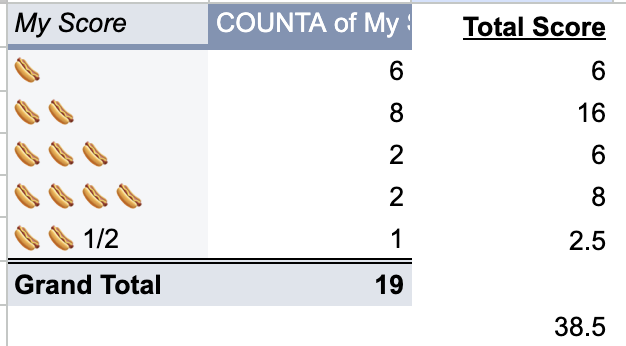
This gave me a nice scorecard for deeming songs ready to release and finishing my album. Additionally, I added other indictator emjoji’s like 🔴, 🛠, or 💀 as quick visual indicator of songs I might cut or was working on.
The next major column that I got alot of benefit from was a management status column. This is an idea I appropriated from my work as a developer and technical project manager and use tools for managing software development projects. For my music production, this column was where I kept track of the overall progress stage of each song from ideation to mixing and mastering. I used different labels for different stages and it was a drop down with the following options:
- Ideation / Draft
- Initial Song Demo
- Weak / Thin
- Minor Revision in Writing/Production - Needs Work
- Nearly Finished (Production/Mixing)
- Production Finished - Needs Mastering
- Written, Produced, Mastered
An simpler alternative might have been “todo,” “in progress,” “on hold,” and “done.” I probably could have done a better job labeling and making the status more precise, but much like a kanban board, the idea of these statuses was to nudge me to move a song from one status to the next as I reworked, improved and eventually finished a track. For example, you could imagine a newly added song starting as “Initial Song Demo” and I’d then move it through a stage or two as I edited and improved the song towards release. This helps me stay organized and focused on the next steps for each song.
I also had a numerical column called Revisions. This was just to track if I had revised a song and how many times. Since my intention was to avoid too many rounds of revisions, this column worked well to help me see how many times I had revised a track and if I had revised it at all. It’s likely a column I’ll use more heavily in the future since I can think of revisions as a general phase before the actual finishing phase of releasing an album. Revisions tracking helped me stay accountable and ensured that I wasmaking progress without getting stuck in a cycle of endless revisions.
The final columns I had were all different forms of checklist columns for tracking progress on the final production work, mixing, mastering, etc. Here is my full list of checklist (i.e. did I do this?) columns:
- Song Reviewed?
- Written / Demo?
- Basic Music Production?
- Instrumentation?
- Needs Work?
- Production Finished?
- Final Title?
- Mastered?
- Rendered as WAVs?
As you can imagine, each of these presented a step in the process of finishing a song. Each of these had a simple yes or no. If it was no, I color coded it red and if yes, it was green. This was a simple visual indicator if I had taken care of that specific test in preparing the track or song for release. Initially I found the song reviewed? column very enabling, because before I had the spreadsheet I wasn’t really going through the next obvious step of consciously reviewing each and every song I was considering.
The other key column I used alot was labeled “[CURRENT] Identified Issues / Problems.” This was a text column and I used it to write down any feedback I had on a track. I tried to keep it to single bullet point each of issues I had heard or changes I wanted to try. Basically this column was all about capturing identified issues and possible solutions. As I reworked the songs I would then cross out those issues or things I tried. After a round of revisions, I stored previous work in this column to the right of my spreadsheet and started fresh.
I also had a similar column “Mastering Issues” for identifying mastering issues as I prepared tracks for release. Mastering is still pretty hard for me to hear and notice differences so I didn’t dwell that long on this stage. If it sounded good for me after listening on a few different devices and dynamics were pretty close overall, I let myself call it complete.
Finally, I had a checklist column called “Song Released?” and column for “Album Assigned” and “Track #” which were basically the last steps geared towards if a song would be selected and sequencing and order. Along with finalizing a title, these were the administrative tasks to finish each and every song.
Overall, using a spreadsheet was a game-changer for my creative process towards finishing my latest album release. It helped me stay organized, focused, and productive, and allowed me to move my songs from ideation to finished production more efficiently.
Case Study: Using the Spreadsheet to Streamline My Creative Process and Decisionmaking on Specific Songs
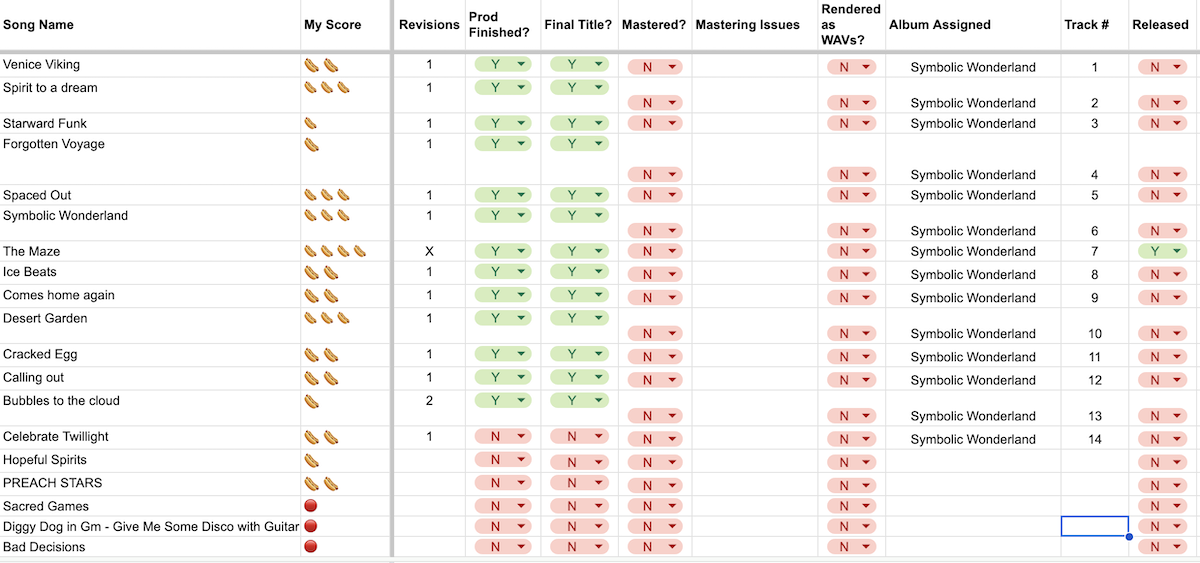
While in my particular situation, having a task and project management spreadsheet enabled me to finish my tracks and overall album release, it is also important to not get too caught up in the spreadsheet per se. What the spreadsheet represents is an externalization or list that makes it obvious what’s done and what’s left to do.
There were many ways this spreadsheet help me manage my time, track progress, and make decisions. When it came to managing my time, having a spreadsheet gave me a visually transparent way to see which tracks had been reviewed or not. Similarly I could see my notes following the review and I could use these to rework a song accordingly. Since I had removed having to think about what songs I should work on, I could just use my energy and mood level to engage with songs at different stages. For example, just having of a tracks I had reviewed vs. needed to review gave me a clear indicator of my progress in completing the review phase.
Since it was going to be impossible to complete it all in a single session, these checkboxes of steps made it easier to piece-meal work on this over time. Initially it was a real unlock to nudge and motivate me to review each song one by one.
Having a well-organized list of songs that were more or less finished removed the struggle of deciding. While it started as joke, my hotdog rating system 🌭🌭🌭 combined with the production management status made it possible filter down my big list of songs to shorter lists based on the rating and status. This shorter list removed some of the scariness and largeness of the project and enabled me to deal with it “bird-by-bird.” For example, I worked through songs that were close to finished and could quickly iterate through several close-to-finished songs in a single session or two of just a couple hours. By completing a solid reworking of these songs and removing them from my list of TODOs helped me get some quick successes and built early momentum.
Subsequently, I could filter my full list to just songs I liked but needed a lot more work. Knowing a song was in need of a harder lift to improve ensured I had the right energy to meet the challenges. Having cleared other songs from my pending work allowed me the energy to focus on that song. Additionally by already having reviewed and captured feedback and notes meant it was fast to jump into my DAW and start trying some changes and make improvements.
During the song finishing phase, which I personally call “Album Reworking,” your aim should to revise songs until you release it or let it go for later. Keep revising and track each revision, even if it’s minor, since building up a habit of revision and tracking it gives you confidence you are moving forward.
One practical and visual way I managed the song revision process with my spreadsheet is by simply highlighting songs I’d revised during that cycle. Along with how many revisions or edits I’d done, I would mark revised songs in GREEN in order to make it clear that I’d improved it to move forward. This made it visually clear which ones I’d done and which ones I hadn’t.
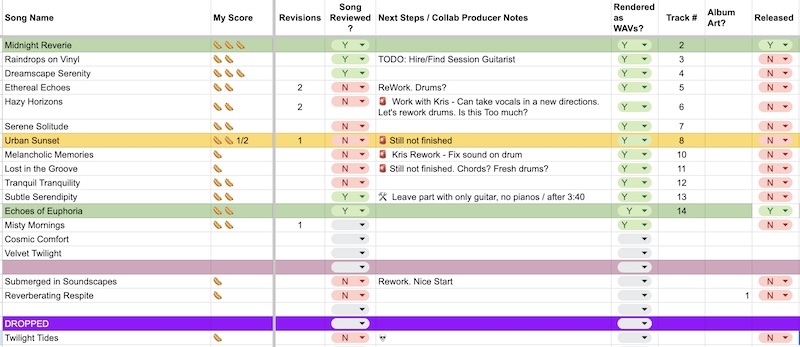
Having a highlighted and sorted list makes it easier to see where I had taken steps and made progress. Along with my ratings system and some notes on each track, I have cues on where I stand on individual tracks which are the building blocks of effectively moving forward and making tangible progress on your creative work.
Finally while I started with about 20 initial songs after my review and attempts at reworking I realized that some songs just didn’t fit the album or weren’t improving to my taste for this particular cycle. If I only had a bunch of songs and not this spreadsheet, it would have been harder to make the decision to let go of these songs. I’m sure I would have spun my wheels trying to fix incomplete songs rather than accepting I already had a bunch of finish and great stuff and need to move the overall project forward. For example, there were several early demos I loved but during revision and review process they just didn’t improve enough; they weren’t ready. The spreadsheet helped me see what I had and recognize that it was ok to not finish or release several beloved tracks for this album.
If you are a music maker who struggles with deciding and moving forward, these kinds of threshold qusestions can help you identify what qualifies as ready and finished and what doesn’t. For example, ask yourself if it the desired sounds are tight? If it’s catchy? Or if you have have reviewed or revised it? Answering these questions can give you confidence in letting go and releasing. You may have particular requirements on your tracks and with a spreadsheet, it is easy to flexibly add those checklist-style questions for your music project.
As a creative, you should still allow room for creative freedom, flexibility, and joy. Depending on your style of music and other promotional and collaboration needs, you should adapt your spreadsheet or organizational tools accordingly. Ultimately, music production is an art form and creative process that should be fun and inspiring as you start, improve and ship creative work. So take breaks. Relisten to early versions with your latest versions to hear how much progress you are making!
Results: Releasing My Latest Album

Following my first album release, Take Life Chill, I struggled to get passionate about making music again. I had skills I needed to improve, but frankly I just needed to get confortable showing up and trying to make more songs with the skills and tools I had. My anecdote to my lack of early song creation was a 30-day song-writing challenge.
Similarly, after struggling to transition and finish the early versions of songs I had, the anecdote was my music production spreadsheet. Basically a list of my songs along with a series of checklists and captured feedback that helped me navigate the next steps, make tangible improvements and relax in knowing it was all organized in a single system.
What was the result? I’m happy to say I completed my album, which includes 14 new previously unreleased songs. I was stretched as a creative to come up with new instrumentations, melodies and finish my musical ideas into finished tracks. As a producer, this particular finishing cycle forced me to level up my production skills on different instruments in a different music genre too. I added new production approaches and plugins. I noticed and improved through active listening sessions (instead of just passive jamming). From these listening critiques I had notes to use when I made fresh production attempts to improve and finish songs.
In terms of the time I’ve put into music, so far in 2023, I have spent and tracked about 91 hours on making music. Interestingly according to my timelogs, about 40 hours of that was spent on finishing this lastest album. Another 26.5 hours was spent on new song writing and jamming. The rest of the time was on music-related studies, organization tasks like goal settings, planning and journaling the process.
If I combine my previous music time from Dec 2022 (about 60 hours) with time spent on music since start of 2023 (about 90 hours), I spent about a total of nearly 150 total hours on music. The breakdown looks like this:
- 80-90 hours on songwriting and early music production a
- ~40 hours on finishing and releasing the album.
While the majority of my music is on making music, I’ve start to put in some additional time on music promotion, especially Spotify Playlisting. It’s impossible to put an exact amount on what went into this album, but my guess is this album was written, revised and finished over 21 weeks and in roughly 135 hours. Put another way, only about 6 hours and 20 minutes per week or a bit less than an hour per day.
Assuming you are well-skilled in your music production tools and are able to find focused hours to start, revise and finish, I believe these are pretty good baseline numbers for an end-to-end album project. Obviously your mileage my vary depending on the complexity of your music and various recording steps. Hopefully these numbers and the creative organizational steps I laid out can guide you in scope and prioritize the time and steps to completing an album.
Conclusion
Finishing creative work is hard. As creatives, it is fun to start new things and just enjoy the moments of creative inspiration. It can feel counterinuitive to do the productive and organizational work associated with finishing. Finishing creative work and shipping are essential though if you want to create and share more art over time. As such, it’s critical to take creative organization and productivity seriously.
Personally, deciding to dump my track list into a spreadsheet was a big unlock for me when I was struggling to finish the album. Using a spreadsheet eliminated the ambiguity of where each track was in the process and enabled me to confidently move forward step by step until I finally finished. I color-coded it so I could visualize what was to do, what was done, and what was next. Unlike the initial song creation process which is driven by flow, the editing and revision process requires more of my critical and analytical brain. A spreadsheet was a perfect fit here.
Personally, I’m a big believer in tracking goal progress and my spreadsheet enabled me to track progress in a very clear and tangible way. It also made it easy to break down finishing my album into a series of single steps on each and every track. Having a spreadsheet removed the ambiguity of where each track was in the process and enabled me to confidently move forward step by step to finally finishing 14 new tracks and release Symbolic Wonderlands by Stellar Mammals.
I encourage musicians and music producers to embrace creative organization in one way or another. One of the primary benefits of using a spreadsheet in music production is organization. A spreadsheet can help you keep track of every aspect of your project, from lyrics and melody to mixing and mastering. By organizing your ideas in a spreadsheet, you can ensure that nothing gets lost or forgotten. Additionally, the spreadsheet allows you to easily track your progress, giving you a clear picture of how far you have come and how much further you need to go.
In the future, I plan to use a spreadsheet earlier in the process. For example, I plan to put all of my new songs into a spreadsheet focused on the songwriting stage and will include columns focused on individual components like drums/groove, bass, instrumentation, chords/keys, arrangement, etc. It might be useful to note the song’s structure as well.
While all of the songs I’ve released to date are instrumentals, I aspire to write lyrics, compose vocal melodies, and sing (or work with a singer) so it makes sense to add columns to manage and track these steps too. I could also include checklists for ensuring that mysong has a clear structure and that my lyrics are polished and effective.
An evolving spreadsheet like this will let me see a song’s status more accurately. I’ll definitely plan to keep my hotdog ratings too since it gives me a way to keep score in a fun but practical way. I also think I’ll track revisions more consciously over time too. I often revise a song without tracking how often it’s been revised. By keeping a log of this I can see the rate of revision as a proxy of readiness and also avoid endless revision cycles too.
One other change both for my spreadsheet and my approach to music production is adding reference tracks. Reference tracks are songs by other artists and can serve at many stages of music production. At the beginning, they can help you get a sense of what you hope to achieve in terms of vibe and instrumentation. As you produce and mix, a reference track can help see how ready a song is. Finally in mastering, you can use a well-mixed and mastered song to accurately see if your song sounds up to the standard set by the reference track. Personally, I hope to use reference tracks to spark creativity in attempt to reproduce, learn techniques and push the boundaries of my skills and abilities too.
Overall, incorporating a spreadsheet into your music production process can help you stay on track, reach your goals, and achieve a more efficient and productive workflow.
📁 Download/copy/edit your own music producer creative spreadsheet
Give it a try and see how it works for you. If you do, drop me a note on how it goes and changes or adjustments you made for your needs!
About Me: I’m a lifelonglearner who is self-taught and fluent in French and Chinese, computer programming, product design and digital marketing. I am a long-time advocate and practitioner for the quantified self and self-tracking in general. I write and blog regularly about technology and personal development on my blog www.markwk.com. You can check out my music on all streaming platforms as Stellar Mammals.
Additional Topics and Readings: If you are interested in my music producer learning journey, check out my post Zero to Album. If you want to explore peak performance and flow, checkout Science of Flow. Finally, if you are interested in understanding more on goals and goal pursuit strategies, I recommend reading a post or two from my on-going blog series on the Science of Goals.
AIDA (AI Disclosure Acknowledgement): The following written content was generated by me with the assistance of an AI-based system (ChatGPT). Specifically I used it to help me in pre-writing phase, copyediting and minor re-writing and drafting a few individual points.

